Family : Lutjanidae

Text © Giuseppe Mazza

English translation by Mario Beltramini
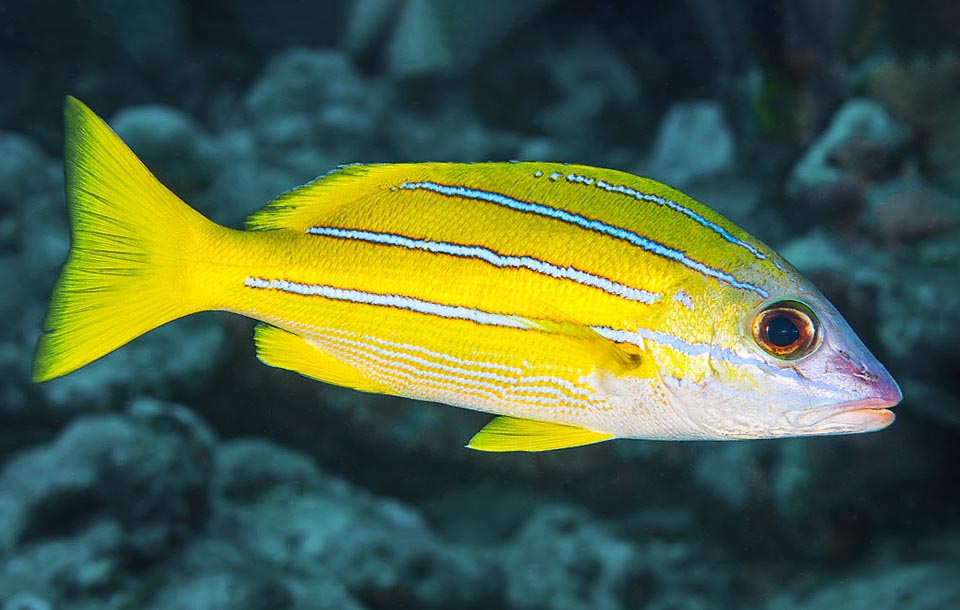
Up to 40 cm long, but usually 25, Lutjanus kasmira is one of the most frequent fishes in the tropical Indo-Pacific © François Libert
Known in English as Common bluestripe snapper and in French as Vivaneau à raies bleues, maybe because of its strong canines with which it seizes the preys, the Blue-banded snapper, Lutjanus kasmira (Forsskål, 1775), taxonomically is not a snapper, because the true ones, like Dentex dentex, belong to the family of the Sparidae.
Conversely, it belongs to the class of the Actinopterygii, the ray-finned fishes, to the vast order of the .
Perciformes, rich of more than 7000 species, and to the family of the Lutjanidae, counting 17 genera and 113 species present in the tropical and subtropical seas of the whole world.
At times spectacular fishes, like Symphorichthys spilurus, frequent in the public aquaria, but above all important for local consumption and abundant in the nets.
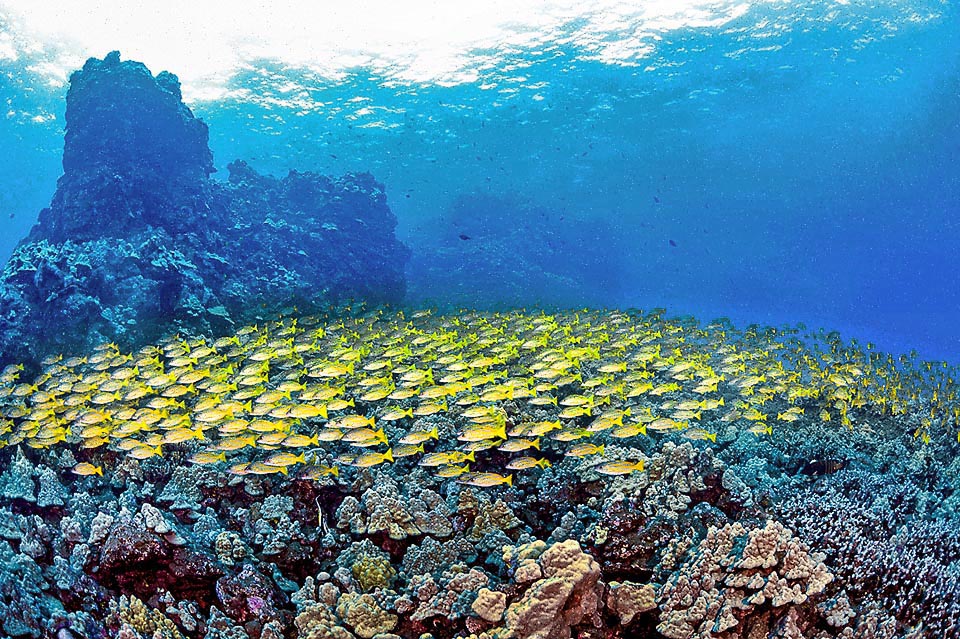
It can form immense schools, like in this dramatic image, and is particularly attached to its own territory © www.davidfleetham.com
In fact the genus Lutjanus, created by Bloch in 1790 and assigned to about 70 species, originates from the local Indonesian name and also the specific kasmira is the one used, in Arabic, by the Red Sea fishermen.
Zoogeography
Lutjanus kasmira is very common in the tropical Indo-Pacific, from the Red Sea and all African coasts to India and Australia and then, eastwards, from Japan and New Zealand up to French Polynesia, the Marquesas Islands and Pitcairn. Starting from 1950 it has been introduced in the Hawaii with specimens coming from French Polynesia to boost local fishing and in a short time has colonized all the archipelago becoming the most abundant species in the nets, without competing too much with the local snappers that go hunting in different depths and environments.
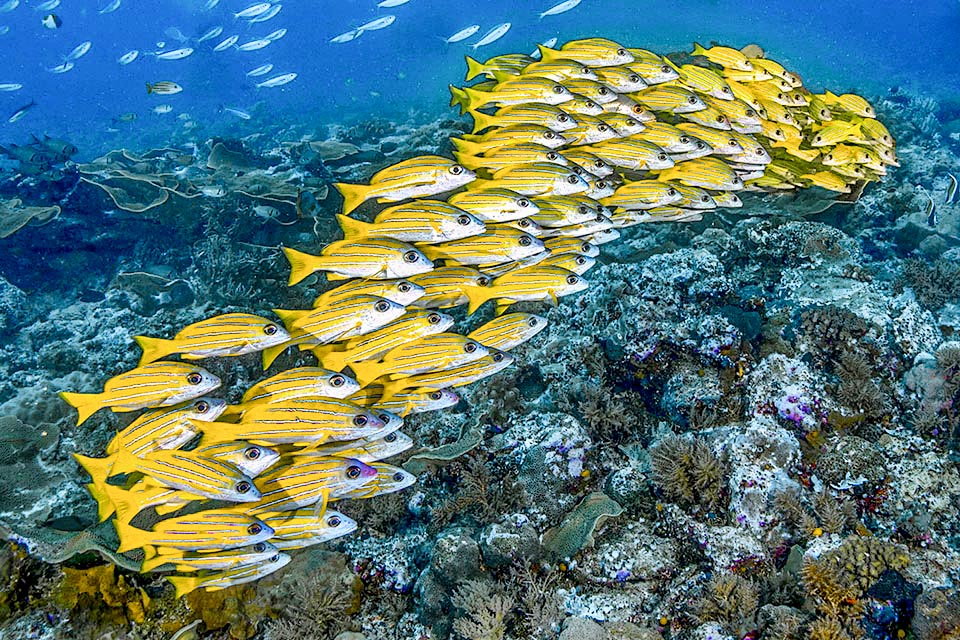
It hunts the night, resting during day always in the same sites, where, compacting, it forms unusual silhouettes as some Caribbean haemulids of analogous appearance do © Mark Rosenstein
As a matter of fact, unlike usual, the biggest specimens of the Bluestripe snapper circulate in relatively shallow waters.
Ecology-Habitat
Lutjanus kasmira may be found from 3 to 265 m of depth, though usually is more abundant between 30 and 150 m. The adults live in madreporic environments whilst the juveniles are more frequent in the submerged prairies of posidonias, the formations of mangroves and the estuaries.
It has been observed that it is a fish attached to its territory with dense schools that rest during the day always in the same locations dispersing then during the night for hunting.
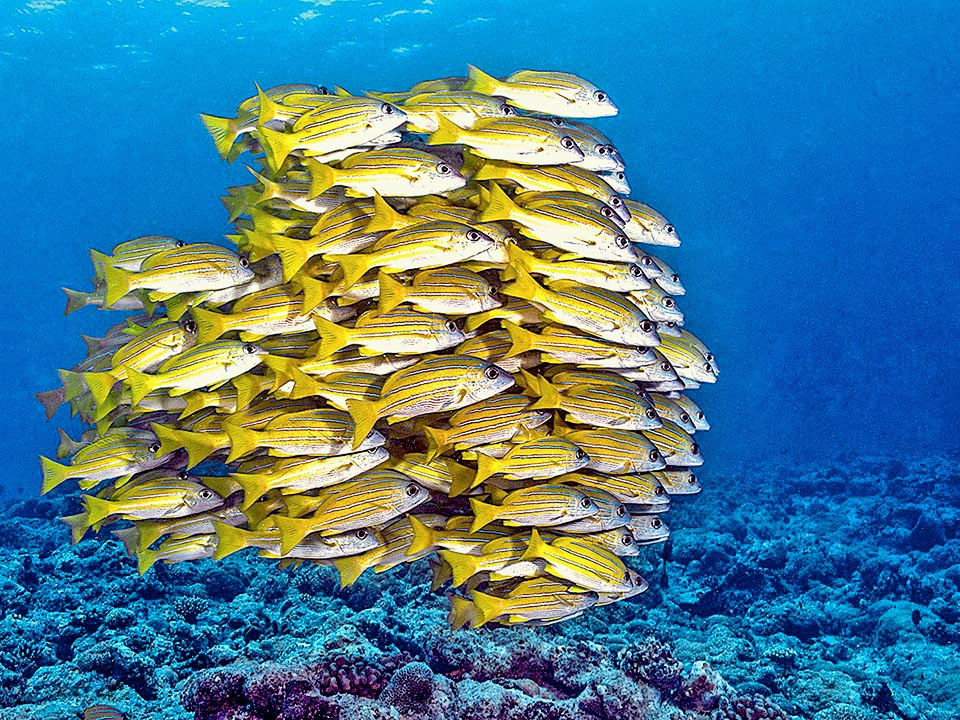
A group mimicry, as seen from far away this strange ball evokes everything but a fish. So much that often it hosts other species like a mullet of similar colour © Rafi Amar
A behaviour that is analogous to what occurs in the Caribbean with Haemulon flavolineatum or Brachygenys chrysargyreum, fishes having a similar livery but belonging to the family of the Haemulidae.
In both instances unity makes strength, offering more, when the school is dense and motionless, a sort of group mimicry because they create a shapeless mass that blends in with the landscape. Furthermore, in the event of attacks, the huge number of fishes, all alike, moving around, often disorientates the predators.
So much that in order to pass unnoticed, even a mullet, Mulloidichthys mimicus, often takes refuge in the school, with folded barbels, imitating perfectly the livery.
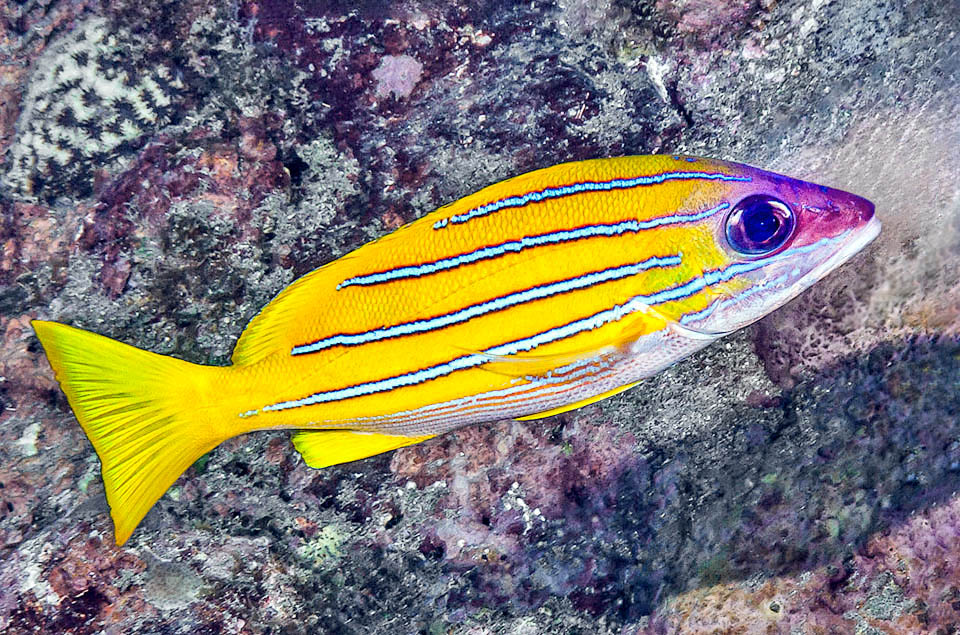
This is the adults’ typical livery: wine-coloured front and four longitudinal turquoise blue bands with dark edge, emphasized by the yellow body © François Libert
Morphophysiology
Lutjanus kasmira may reach the length of 40 cm, even if the current size is of around 25 cm.
The body, fusiform, compressed on the sides, has the profile of the straight head, inclined towards the pointed snout.
In the adults the front is of wine colour, but what immediately catches the eye are the four longitudinal bands of the livery, turquoise blue with dark edge, emphasized by the yellow body.
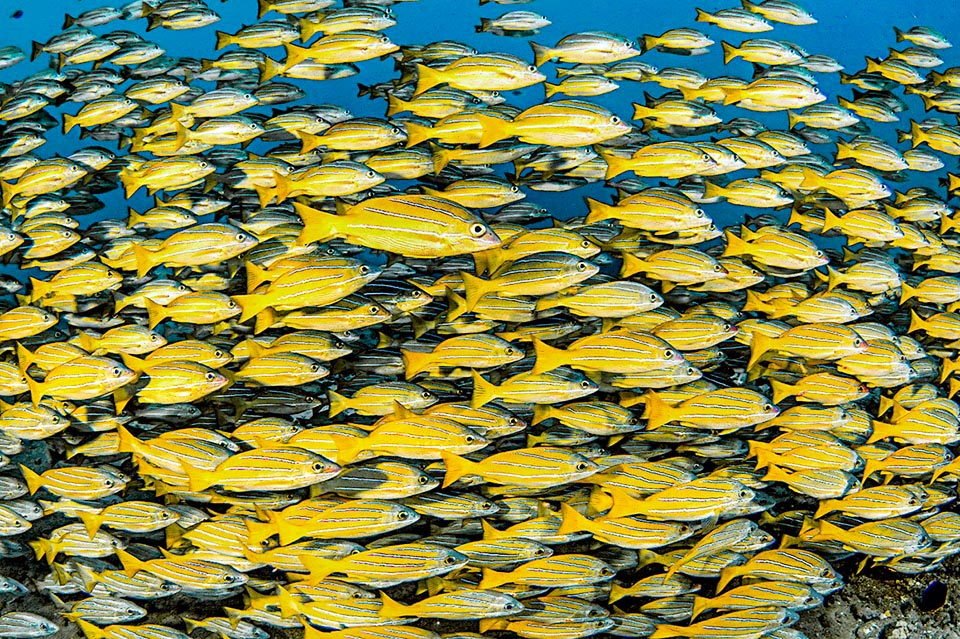
Lutjanus kasmira eats fishes, cuttlefishes, squids, shrimps, crabs and planktonic crustaceans. At times it also grazes algae and phanerogams © www.davidfleetham.com
The first band begins over the eye reaching the first third of the dorsal fin. The second, just below, longer, goes from the upper edge of the eye to two thirds of the dorsal. The third begins on the preoperculum and reaches the upper part of the caudal peduncle. The fourth one, the longest, starts under the eye, aligned to the tip of the snout, and ends in the middle of the peduncle.
Under the belly it is white, often adorned with thin yellowish streaks, partly hatched.
The scales are ctenoid and the lateral line, very important for fishes swimming in schools, starts from the second blue band with 48-51 sensory scales and follows the profile of the fish up to the tail.
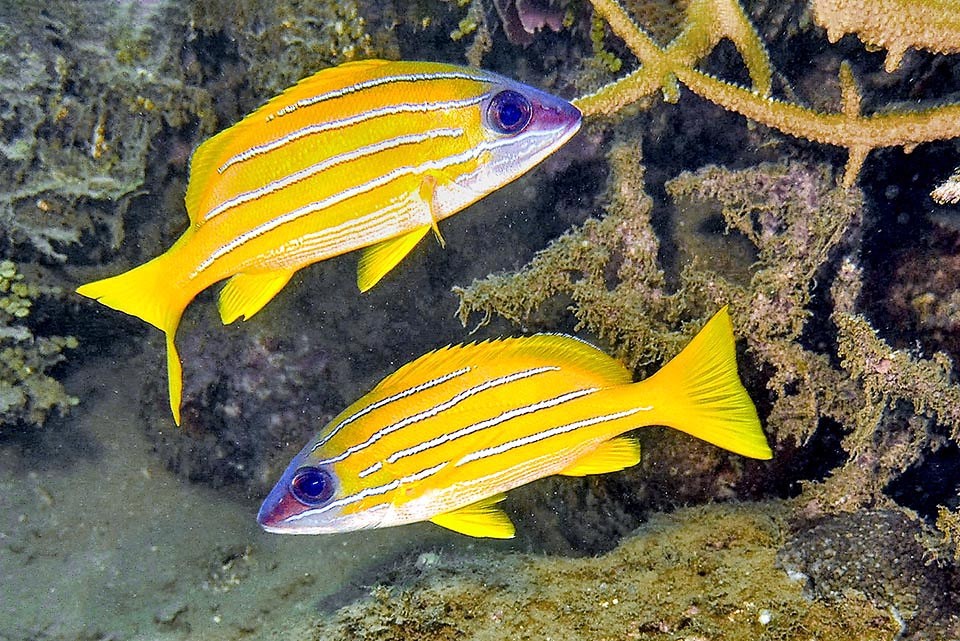
Reproduction doesn’t occur in group but in couples that go up swimming spirally to entrust to the currents the eggs once in surface © Karine Marangon
There is only one dorsal fin with 10 spiny rays and 14-15 soft. The anal has 3 spiny rays and 7-8 unarmed. The pectoral ones have 15-17 soft rays, the pelvic do not have spines and the caudal in the adults is almost truncated.
Moreover, the juveniles distinguish for the characteristic blackish band going from the tip of the snout to the eye.
Ethology-Reproductive Biology
Lutjanus kasmira nourishes of various fishes of modest size, often attacking the young Ctenochaetus striatus, but also of cuttlefishes and squids, shrimps, crabs and planktonic crustaceans. Sometimes it grazes also algae and phanerogams.
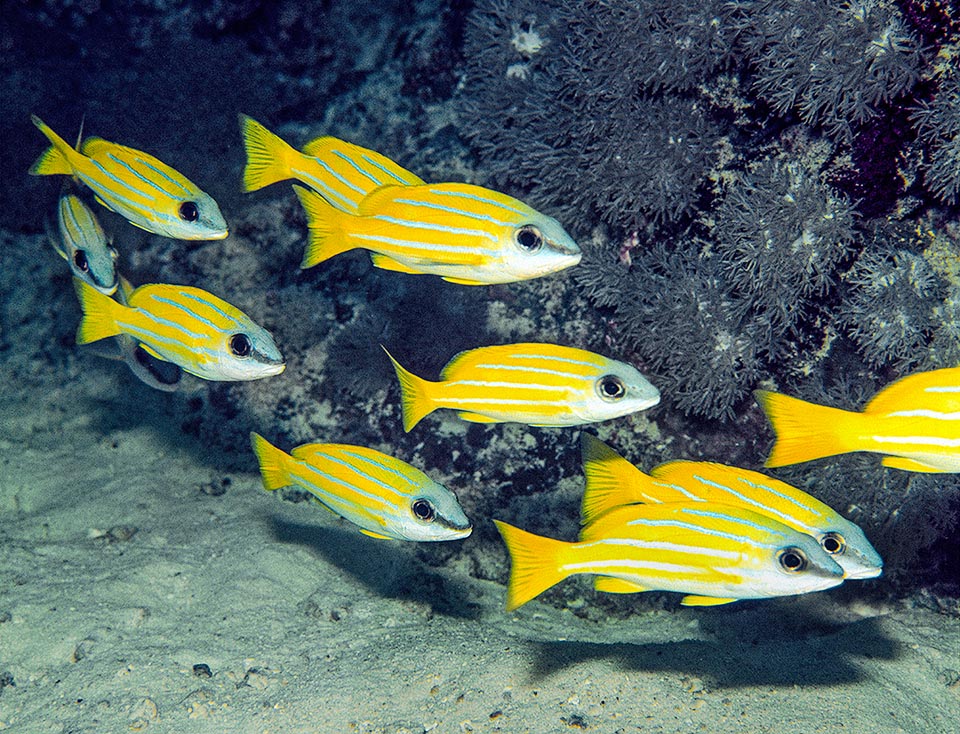
They hatch only 18 hours and the larvae are planktonic. Here a group of juveniles that will reach the sexual maturity around the third year © Giuseppe Mazza
Practically, it produces all over the year in couples that momentarily separate from the school. They ascend swimming spirally towards the surface in the overlying column of water,with the male below, waiting for the eggs that it pecks several times, to stimulate her, the belly of the partner.
These measure 0,78-0,85 mm, are floating, and, entrusted to the currents, hatch after about 18 hours.
The eggs are pelagic, the sexual maturity is reached when 3 years old, when about 20 cm long, and the longevity of the Blue-banded snapper is of about one decade.
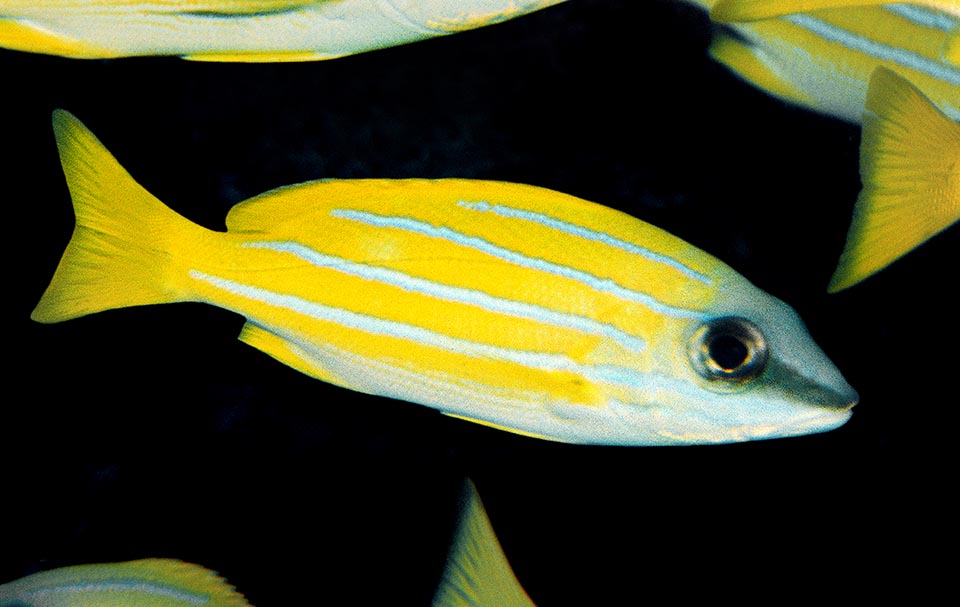
They distinguish from adults for the not yet truncated caudal fin and a characteristic blackish band going from the tip of the snout to the eye © Giuseppe Mazza
The resilience of the species is mediocre with a possible doubling of the populations in 1,4-4,4 years, and the fishing vulnerability, moderate, marks only 40 on a scale of 100, although the Blue-banded snapper is hunted every day with lines and nets by the natives, regardless of a small risk of ciguatera, the food poisoning linked to the diet of these fishes.
Also considering the widespread diffusion, Lutjanus kasmira appears however from 2012 as “LC, Least Concern” in the IUCN Red List of the endangered species.
Synonyms
Sciaena kasmira Fabricius, 1775; Mesoprion etaape Lesson, 1831.
→ For general information about fishes please click here.
